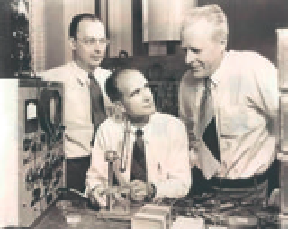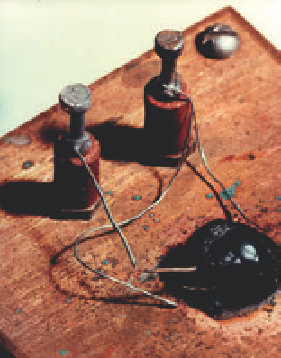Information Technology Reference
In-Depth Information
Fig. 7.5. The first transistors: (a) replica
of the point-contact transistor invented
by John Bardeen and Walter Brattain.
The wedge of semiconductor that forms
the base is about three centimeters on
each side. (b) William Shockley's junc-
tion transistor consisted of a thin layer
of n-type semiconductor sandwiched
between two thicker regions of p-type
material.
(a)
(b)
general aim of the program was to obtain as complete an understanding as
possible of semiconductor phenomena, not in empirical terms, but on the basis
of atomic theory.”
2
A replica of Bardeen and Brattain's first transistor, called a
point-contact transistor
, is shown in
Figure 7.
5a
. The two scientists first succeeded
in observing amplification of a signal by this device on 24 December 1947. This
discovery was followed in 1951 by Shockley's
p-n-p junction transistor
(
Fig. 7.4b
).
This device turned out to be much more reliable and easier to manufacture
than the point-contact transistor.
A junction transistor consists of a thin layer of n-type semiconductor sand-
wiched between two thicker regions of p-type material (
Fig. 7.6
). A transistor
has three
electrodes
, conductors that can emit or collect electrons or holes, or
that can be used to control the movement of the current through the device.
Thus the current flowing in the electrode called the
collector
is controlled by a
small current applied to the electrode called the
base
. In a p-n-p transistor, a
large current through the high-resistance collector-base p-n junction can be
controlled by a small current through the low-resistance base-emitter n-p junc-
tion (see
Fig. 7.6
). This action can be understood by a detailed consideration of
the energy levels and the electron and hole currents across the two p-n junc-
tions. The word
transistor
refers to this effect and comes from combining the
two words
trans
fer and re
sistor.
The first commercial application of transistors
was in hearing aids, followed soon after by the first portable transistor radio
produced in 1955 by a company called Regency in Indianapolis. However, tran-
sistors also proved to be ideal for implementing the “on-off” binary logic of
computers. Their speed and reliability, together with a large number of incred-
ible engineering advances, have made them the basic ingredient of modern
microelectronics.
One of the most important of the engineering advances leading to the devel-
opment of the modern electronics industry was first envisioned by a British engi-
neer named Geoffrey Dummer (
B.7.3
). He worked at the Telecommunications
Research Establishment (later the Royal Radar Research Establishment), a
research facility in Malvern, England. Dummer was an expert on the reliability
of electronic components and was concerned about the performance of radar
equipment under extreme conditions. He realized that it was both inefficient
Emitter
Collector
P
N
P
Base
I
B
I
C
I
E
V
BE
V
CB
Fig. 7.6. Schematic of a PNP transistor
illustrating the direction of currents (I)
and voltages (V). The current to the emit-
ter is the sum of the currents of the base
and collector (I
E
= I
B
+ I
C
).
B.7.2. The three inventors of
the transistor, from left to right,
John Bardeen (1908-91), William
Shockley (1910-89), and Walter
Brattain (1902-87). They were
awarded the 1956 Nobel Prize for
Physics. Bardeen went on to win a
share of a second Nobel Prize for
Physics for his work on the theory of
superconductivity.












Search WWH ::

Custom Search